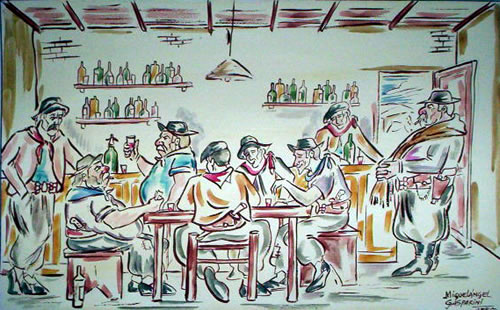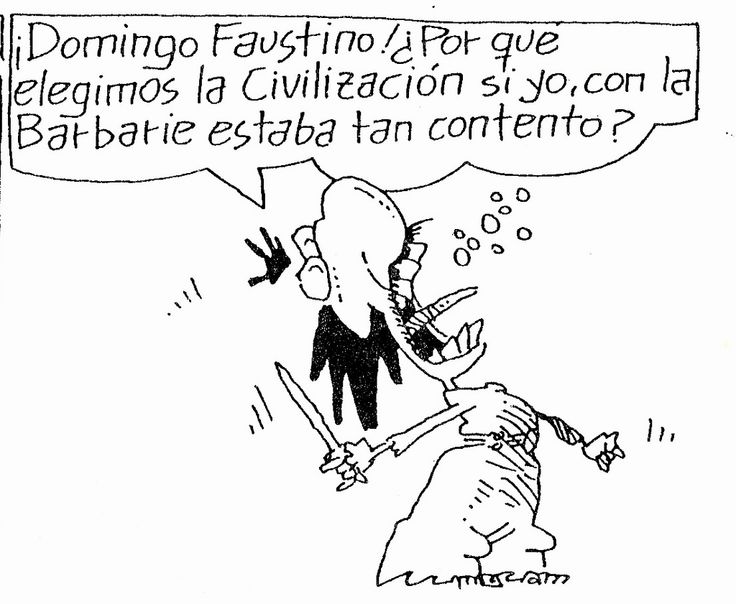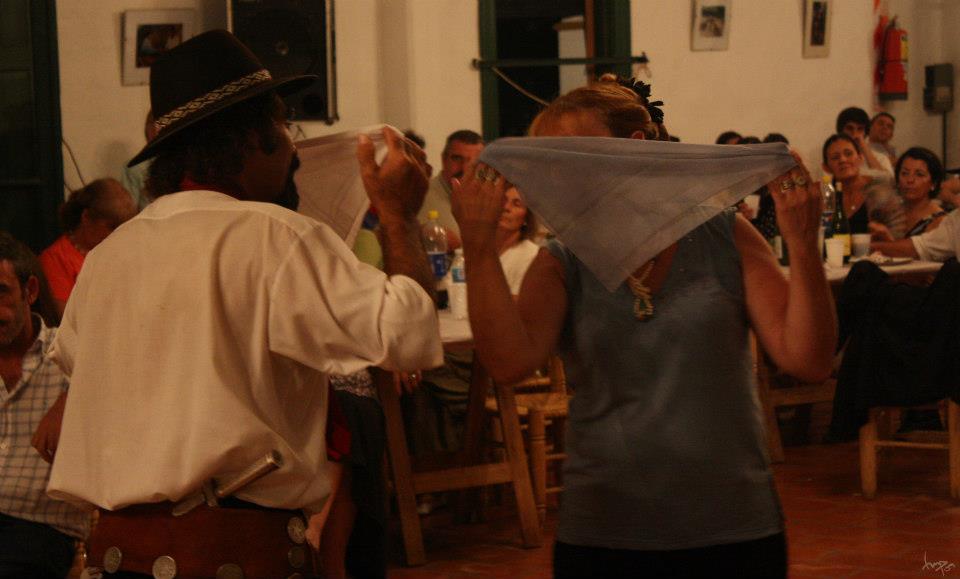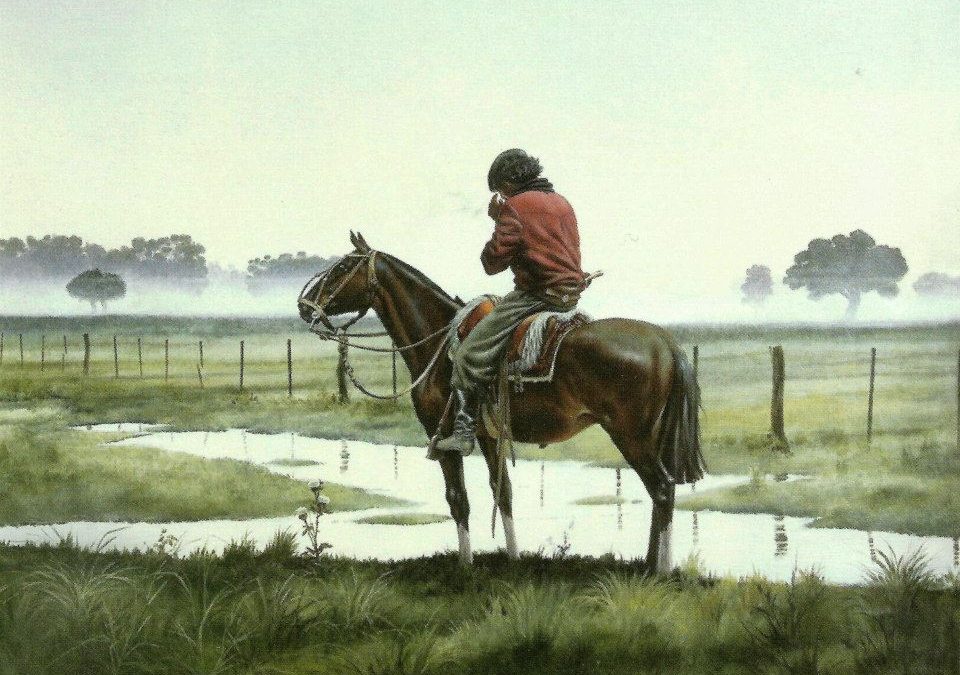
by Carolina González | Aug 9, 2016 | Traditions
Areco’s Art: MIGUELANGEL GASPARINI, EL PINTOR DEL PUEBLO.
Todas la mañanas después de unos mates se va al colegio para darle clases de arte a los chicos. Allí, les enseña la técnica y cuenta historias de nuestro pueblo o de algún lugar remoto. Por la tarde repite el mismo rito con los visitantes en su MUSEO LA RECOVA, ubicado en la esquina de Segundo Sombra y Zapiola, frente al Boliche de Bessonart. El dibujo lineal es lo que lo caracteriza, y la habilidad para contar historias, nos remiten a los bardos de tiempos remotísimos. Si visitas Areco y no estuviste con “Gaspa”, te estas perdiendo algo bueno.
Consejo: Si lo buscas, hacelo por la tarde.
Areco’s art: MIGUELANGEL Gasparini, PAINTER OF THE TOWN.
Every morning after some mates he goes to school to give art classes to kids. There, he teaches the technique and tells stories about our people or some remote place. In the afternoon he repeats the same ritual with visitors in his RECOVA MUSEUM located at the corner of Segundo Sombra and Zapiola, opposite to the “boliche” of Bessonart. The line drawing is what characterizes his work. If you visited Areco and did not meet “Gaspa”, you missed something good.
Tip: If you are looking for him, do it in the afternoon.

by Carolina González | Aug 9, 2016 | Las Pampas, Traditions
About the gaucho comic strip:DISTINGUISHED VISITOR: INODORO PEREYRA
Fontanarrosa as the author of the”stainless” Inodoro Pereyra, could not be indifferent to San Antonio de Areco. In his bullet under the title of “The Sorcerer Roani”, he presents the gaucho “Inodoro” very ill and with little strength to continue living; and in his baleful bed, his will and memories make reference to the town of Areco.
EL VISITANTE ILUSTRE: INODORO PEREYRA
Fontanarrosa como autor del “inoxidable” Inodoro Pereyra , no podía ser indiferente a San Antonio de Areco. En su viñeta bajo el titulo de “El brujo Roani”, nos presenta al gaucho Inodoro muy enfermo y con pocas fuerzas para seguir viviendo; y en su lecho funesto, su testamento y recuerdo al Pago de Areco…

by Carolina González | Jun 24, 2016 | Events, Traditions
Areco: represents a gaucho culture, and it is a folkloric town which sings and dances, too. Here, a gallery of photographs on gaucho’s artistic expressions
More on sanantoniodeareco.travel

by Carolina González | Jun 24, 2016 | Las Pampas, Traditions
Rodolfo Ramos is one of the most meticulous observers of our traditional customs. His thoroughness to reflect places and people have transformed him into an important example of regional culture. And for San Antonio de Areco it is a honour to count with his permanent visits to this antique colonial town. This selection of works integrated the exposition “Fijando Rastros”(“Setting Tracks”), organized by Museum “Las Lilas” in Areco.

by Carolina González | Jun 22, 2016 | Horses, Las Pampas, Traditions
The Don Segundo Sombra book was illustrated in 1929 by the cousin of Ricardo Güiraldes .
He was an amazing artist, and observing his works we see that time in San Antonio de Areco stopped literally…at a bar.
His technique consists on precise and strong, clean lines.
In the Ricardo Güiraldes Gaucho Museum located within the Parque Criollo there are many examples of these Alberto Güiraldes drawings.
All of them representing gaucho situations in the Pampas, most of them real scenes that he was living in his daily life in Estancia La Porteña near San Antonio de Areco
At the entrance of the Museum you can read: If you want to know the work of Güiraldes, the story of Don Segundo Sombra and how rural people think, you’d better go to the museum named after the writer.
For a great visit to this gaucho town look for a Full Day Tour to San Antonio de Areco
Or if you prefer to stay longer: An Historical Estancia Hotel
The Don Segundo Sombra book even though it may be considered as a continuity with Martín Fierro, more than an extiguished gaucho elegy it proposes new ethical examples to a youth that Ricardo Güiraldes considered disoriented and restless mainly. Structured in a basic way as lessons to be absorbed escaping from inexperience, lessons on work, amusement, morals, camp chores (horse taming, cattle rodeo “jineteada”, raw hide pieces of work done by the gauchos, animal healing, etc.), they become an example of “lo criollo” supported by a very specific and precise words.





